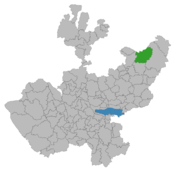Encarnación de Díaz
| Encarnación de Díaz | |
|---|---|

Kiosk in the main plaza
|
|
 Location within the state of Jalisco |
|
| Location within the state of Jalisco | |
| Coordinates: 21°31′N 102°14′W / 21.517°N 102.233°W | |
| Country |
|
| State | Jalisco |
| Municipality | Encarnación de Diaz |
| Founded | 1760 |
| Government | |
| • Municipal President | Jose del Refugio Quesada Jasso (PAN) |
| Area | |
| • Total | 1,296.97 km2 (500.76 sq mi) |
| Population (2010) | |
| • Total | 51,396 |
Encarnación de Díaz is a town and municipality located in the far northeast of the state of Jalisco in north central Mexico. It is located in a natural pass that connects the Los Altos region of Jalisco to points north, and from pre Hispanic times until the 20th century, it was a major thoroughfare for north-south travel. The town began as a way station along a road built through this pass in the 17th century, formally becoming a town in 1760. It began to function as a municipality in the latter 19th century, but this status was not confirmed until the early 20th. Transport, along with numerous prosperous haciendas supported the economy of the area until the early 20th century, when travel patterns and the Mexican Revolution spurred its decline. In the 1920s, it was a center of rebellion during the Cristero War, and the town contains Mexico’s only museum exclusively dedicated to this episode in history. It also contains a museum dedicated to various naturally occurring mummies which have been found in the municipal cemetery.
Because of the area’s prosperity from colonial times to the Porfirio Díaz period, the town has about 180 constructions with historical value. The main landmarks are the Encarnación parish, the Señor de Misericordia Cemetery, the Municipal Palace, the Jesús, María y José Sanctuary, Nuestra Señora de Guadalupe church and the Dr. Pedro de Alba and the Astrónomo Angel Anguiano Limón Library.
One local custom which is still observed is the closing of businesses on Thursday afternoons. This is done because many businesses are open half day on Sunday. The most important celebration for the year is Candlemas in honor of the image of Our Lady of Incarnation. This extends from 25 January to 9 February with the peak on 2 February. The image is honored with masses, processions, bullfights, cockfights, horse races, parades, cultural events and general fair rides and games. In the homes and restaurants of the area, typical dishes include corn ball soup, tamales, puchero, mole ranchero, pozole, birria, menudo and meat with a chile Colorado sauce. Traditional drinks include pulque, tepache, tejuino, atole and a drink made with cactus fruit. It is said that both John Paul II and the King of Spain have tried the town’s sweet bread.
...
Wikipedia

